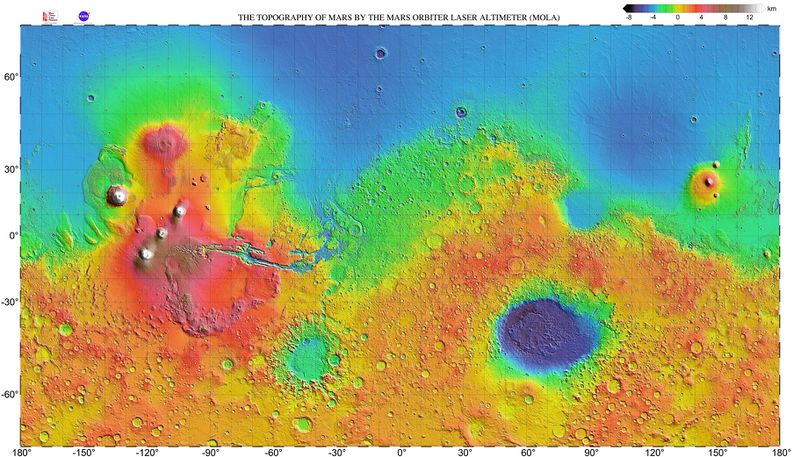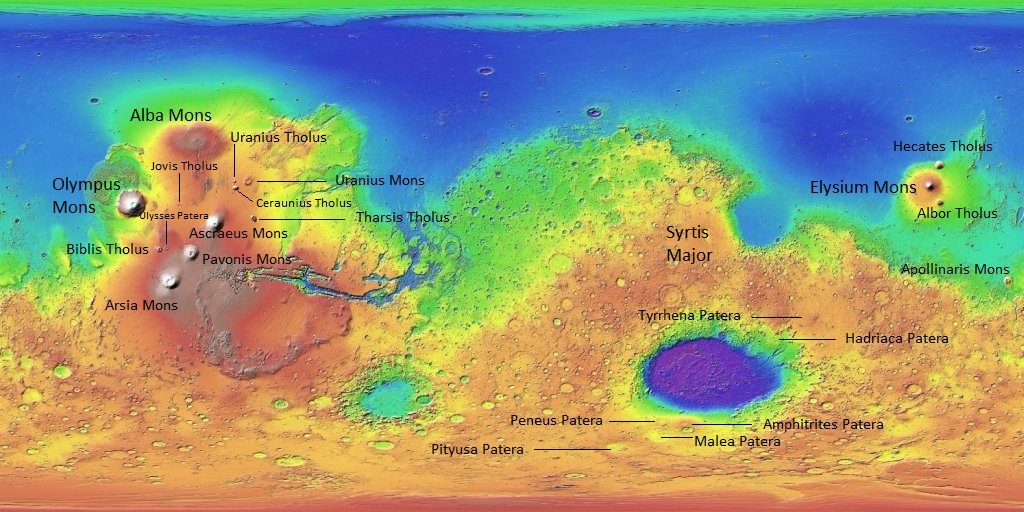Difference between revisions of "Mars volcanoes"
(added links) |
|||
| (4 intermediate revisions by 2 users not shown) | |||
| Line 1: | Line 1: | ||
| + | {{Mars atlas}} | ||
| + | <imagemap> | ||
| + | File:Mars topography (MOLA dataset) HiRes (1).jpg|left|thumb|800x800px|Volcanoes on Mars. Mola dataset. | ||
| + | rect 70 80 2370 200 [[Mare Boreum quadrangle|Mare Boreum]] | ||
| + | |||
| + | rect 2160 490 2190 520[[Hecates Tholus]] | ||
| + | |||
| + | rect 70 200 445 520[[Diacria quadrangle|Diacria]] | ||
| + | rect 444 200 840 520[[Arcadia quadrangle|Arcadia]] | ||
| + | rect 840 200 1210 520[[Mare Acidalium quadrangle|Mare Acidalium]] | ||
| + | rect 1210 200 1600 520[[Ismenius Lacus quadrangle|Ismenius Lacus]] | ||
| + | rect 1600 200 1990 520[[Casius quadrangle|Casius]] | ||
| + | rect 1990 200 2370 520[[Cebrenia quadrangle|Cebrenia]] | ||
| + | |||
| + | rect 320 560 400 630[[Olympus Mons]] | ||
| + | rect 620 760 940 830[[Valles Marineris|Valles Marineris]] | ||
| + | rect 540 720 620 800[[Noctis Labyrinthus|Noctis Labyrinthus]] | ||
| + | rect 2130 540 2190 590[[Elysium Mons|Elysium Mons]] | ||
| + | rect 535 625 565 660[[Ascraeus Mons|Ascraeus Mons]] | ||
| + | rect 480 700 510 740[[Pavonis Mons|Pavonis Mons]] | ||
| + | rect 435 750 470 795[[Arsia Mons|Arsia Mons]] | ||
| + | rect 2340 800 2370 900[[Ma'adim Vallis|Ma'adim Vallis & Gusev crater]] | ||
| + | rect 2080 740 2120 770[[Gale Crater]] | ||
| + | |||
| + | rect 70 520 340 720[[Amazonis quadrangle|Amazonis]] | ||
| + | rect 340 520 630 720[[Tharsis]] | ||
| + | rect 630 520 930 720[[Lunae Palus quadrangle|Lunae Palus]] | ||
| + | rect 930 520 1210 720[[Oxia Palus quadrangle|Oxia Palus]] | ||
| + | rect 1210 520 1500 720[[Arabia quadrangle|Arabia]] | ||
| + | rect 1500 520 1790 720[[Syrtis Major quadrangle|Syrtis Major]] | ||
| + | rect 1790 520 2080 720[[Amenthes quadrangle|Amenthes]] | ||
| + | rect 2080 520 2370 720[[Elysium quadrangle|Elysium]] | ||
| + | |||
| + | rect 70 720 340 920[[Memnonia quadrangle|Memnonia]] | ||
| + | rect 340 720 630 920[[Phoenicis Lacus quadrangle|Phoenicis Lacus]] | ||
| + | rect 630 720 930 920[[Coprates quadrangle|Coprates]] | ||
| + | rect 930 720 1210 920[[Margaritifer Sinus quadrangle|Margaritifer Sinus]] | ||
| + | rect 1210 720 1500 920[[Sinus Sabaeus quadrangle|Sinus Sabaeus]] | ||
| + | rect 1500 720 1790 920[[Iapygia quadrangle|Iapygia]] | ||
| + | rect 1790 720 2080 920[[Mare Tyrrhenum quadrangle|Mare Tyrrhenum]] | ||
| + | rect 2080 720 2370 920[[Aeolis quadrangle|Aeolis]] | ||
| + | |||
| + | rect 70 920 445 1240[[Phaethontis quadrangle|Phaethontis]] | ||
| + | rect 444 920 840 1240[[Thaumasia quadrangle|Thaumasia]] | ||
| + | rect 840 920 1210 1240[[Argyre quadrangle|Argyre]] | ||
| + | rect 1210 920 1600 1240[[Noachis quadrangle|Noachis]] | ||
| + | rect 1600 920 1990 1240[[Hellas quadrangle|Hellas]] | ||
| + | rect 1990 920 2370 1240[[Eridania quadrangle|Eridania]] | ||
| + | |||
| + | rect 70 1240 2370 1400 [[Mare Australe quadrangle|Mare Australe]] | ||
| + | |||
| + | </imagemap> | ||
| + | |||
| + | |||
| + | <div style="position: absolute; left: 165px; top: 172px">[[Alba Mons|'''''●Alba_Mons''''']]</div> | ||
| + | <div style="position: absolute; left: 120px; top: 224px">[[Olympus Mons|'''''●Olympus_Mons''''']]</div> | ||
| + | <div style="position: absolute; left: 180px; top: 245px">[[Ascraeus Mons|'''''●Ascraeus_Mons''''']]</div> | ||
| + | <div style="position: absolute; left: 164px; top: 264px">[[Pavonis Mons|'''''●Pavonis_Mons''''']]</div> | ||
| + | <div style="position: absolute; left: 146px; top: 284px">[[Arsia Mons|'''''●Arsia_Mons''''']]</div> | ||
| + | <div style="position: absolute; left: 610px; top: 210px">[[Elysium Mons|'''''Elysium_Mons●''''']]</div> | ||
| + | <div style="position: absolute; left: 609px; top: 193px">[[Hecates Tholus|'''''Hecates_Tholus●''''']]</div> | ||
| + | <div style="position: absolute; left: 650px; top: 286px">[[Apollinaris Mons|'''''Apollinaris_Mons●''''']]</div> | ||
| + | |||
[[File:Mars MGS colorhillshade mola 1024volcanoessyrtis.jpg|600pxr|Topo map showing location of major volcanoes]] | [[File:Mars MGS colorhillshade mola 1024volcanoessyrtis.jpg|600pxr|Topo map showing location of major volcanoes]] | ||
| Line 13: | Line 76: | ||
Built up by countless generations of lava flows and ash, the Tharsis bulge contains some of the youngest lava flows on Mars, but the bulge itself is believed to be very ancient. Geologic evidence indicates that most of the mass of Tharsis was in place by the end of the Noachian Period, about 3.7 billion years ago (Gya). Tharsis is so massive that it has placed tremendous stresses on the planet's lithosphere, generating immense extensional fractures (grabens and rift valleys) that extend halfway around the planet. The mass of Tharsis could have even altered the orientation of Mars' rotational axis, causing climate changes | Built up by countless generations of lava flows and ash, the Tharsis bulge contains some of the youngest lava flows on Mars, but the bulge itself is believed to be very ancient. Geologic evidence indicates that most of the mass of Tharsis was in place by the end of the Noachian Period, about 3.7 billion years ago (Gya). Tharsis is so massive that it has placed tremendous stresses on the planet's lithosphere, generating immense extensional fractures (grabens and rift valleys) that extend halfway around the planet. The mass of Tharsis could have even altered the orientation of Mars' rotational axis, causing climate changes | ||
| + | |||
| + | ==External links== | ||
| + | |||
| + | *[https://en.wikipedia.org/wiki/Volcanology_of_Mars Volcanology of Mars] | ||
| + | |||
| + | *[https://www.youtube.com/watch?v=RYG-HLr33CM Martian Geology - Jim Secosky - 16th Annual International Mars Society Convention] | ||
Latest revision as of 16:02, 21 April 2020
Major volcanoes on Mars
Mars today has no active volcanoes. Much of the heat stored inside the planet when it formed has been lost, and the outer crust of Mars is too thick to allow molten rock from deep below to reach the surface. However, Volcanic activity, or volcanism, has played a significant role in the geologic evolution of Mars and it has the largest shield volcanoes in the solar system. Three enormous volcanoes, Ascraeus Mons, Pavonis Mons, and Arsia Mons (collectively known as the Tharsis Montes), sit aligned northeast–southwest along the crest of the bulge. The vast Alba Mons (formerly Alba Patera) occupies the northern part of the region.
Olympus Mons stands 26 kilometers (15.5 miles) above the surrounding plains, and is 500 kilometers (300 miles) wide at its base. It is about two and a half times Mount Everest's height above sea level. It is the largest volcano, the tallest planetary mountain, and the second tallest mountain currently discovered in the Solar System, comparable to Rheasilvia on Vesta. In terms of surface area, Olympus Mons is the second-largest volcano in the solar system, second only to Earth's Tamu Massif. Olympus Mons is the youngest of the large volcanoes on Mars, having formed during Mars's Hesperian Period. It had been known to astronomers since the late 19th century as the albedo feature Nix Olympica (Latin for "Olympic Snow"). Its mountainous nature was suspected well before space probes confirmed its identity as a mountain.
Olympus Mons is located in Mars's western hemisphere at approximately 18.65°N 226.2°E, just off the northwestern edge of the Tharsis bulge. The western portion of the volcano lies in the Amazonis quadrangle (MC-8) and the central and eastern portions in the adjoining Tharsis quadrangle (MC-9).
The western hemisphere of Mars is dominated by a massive volcano-tectonic complex known as the Tharsis region or the Tharsis bulge. This immense, elevated structure is thousands of kilometers in diameter and covers up to 25% of the planet's surface. Averaging 7–10 km above datum (Martian "sea" level), Tharsis contains the highest elevations on the planet. Three enormous volcanoes, Ascraeus Mons, Pavonis Mons, and Arsia Mons (collectively known as the Tharsis Montes), sit aligned northeast–southwest along the crest of the bulge. The vast Alba Mons (formerly Alba Patera) occupies the northern part of the region. The huge shield volcano Olympus Mons lies off the main bulge, at the western edge of the province.
Built up by countless generations of lava flows and ash, the Tharsis bulge contains some of the youngest lava flows on Mars, but the bulge itself is believed to be very ancient. Geologic evidence indicates that most of the mass of Tharsis was in place by the end of the Noachian Period, about 3.7 billion years ago (Gya). Tharsis is so massive that it has placed tremendous stresses on the planet's lithosphere, generating immense extensional fractures (grabens and rift valleys) that extend halfway around the planet. The mass of Tharsis could have even altered the orientation of Mars' rotational axis, causing climate changes








